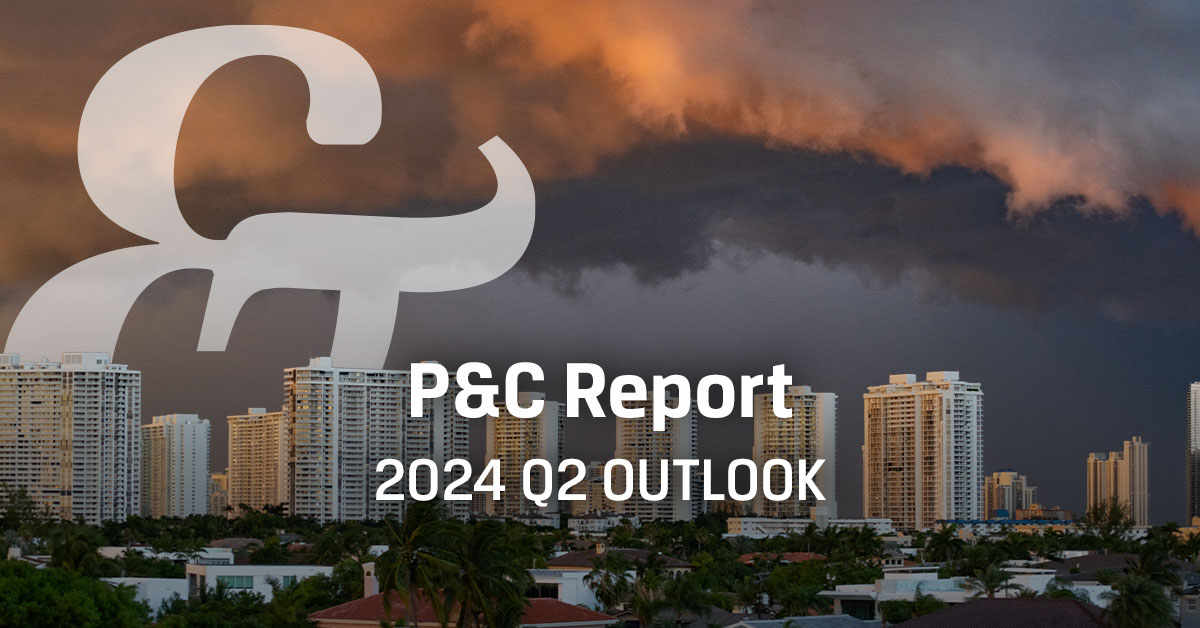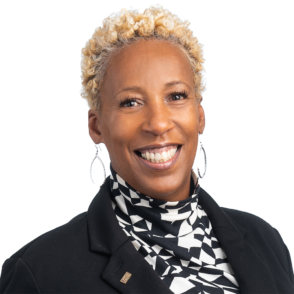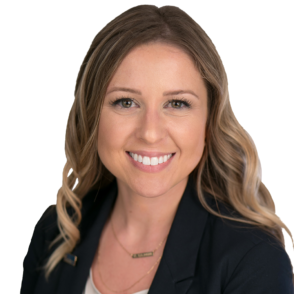Following several years of double-digit rate increases and restrictive adjustments to Terms and Conditions (T&C), the Property Insurance sector has reached a point of relative stability. Rates are largely modest as insurers secure the required premium, now applying rates against a proper exposure basis—Insurance to Value (ITV). With few exceptions of traditional CAT-prone perils in specific geographies, most carriers are profitable in the Property space with capacity readily available for qualified insureds.
KEY TAKEAWAYS:
- Insured losses from 2024 Atlantic hurricane season will have a significant impact on the future of the Property market
- Potential impact of the “creep” from adverse loss development of Liability from 2016–2020
- Underwriting integrity is here to stay
- Continued expansion of the E&S market to help support stressed sectors in the industry
ACCESS A PDF VERSION OF THIS REPORT HERE
As a result, we are tracking a new Property challenge—avoiding a market shift in the wrong direction. In some ways, it is similar to the dance the U.S. Federal Reserve is having to do with inflation and interest rates. With common sense policies and a little luck, the Federal Reserve is hoping to complete that “soft landing” that all economists are seeking. A similar soft landing in the Property space in the Insurance sector would maintain rate and capacity equilibrium for the time being.
That is easier said than done. Carriers that exited the Property market are returning, and newer carriers are entering it for the first time. We must remain disciplined with higher supply as demand remains strong. Failure to do so could throw off the equilibrium we have largely achieved. While there is underlying unease if this can be achieved, the current picture is positive.
That brings us to the Liability space where several factors are forcing a tightening in the market. Some carriers have already begun to adjust their loss reserves of earlier years while social and economic inflation worsens.
All of the ingredients exist for a continued tightening of limits, and T&C by Insurers to fend off the increased severity and frequency of Liability losses.
These financial “adjustments” increase the probability of merger and acquisition activity within the Insurance sector. Some carriers are currently pursuing strategic alternatives, like when Brookfield Reinsurance acquired Argo Insurance for $1.1 billion in November 2023. Larger companies like Argo have experienced downward pressure on their stock prices, causing acquisition interest from smaller, private companies with healthier balance sheets. Firms with a strong insurance specialization tend to be financially healthier, contributing to the ongoing consolidation.
In short, Liability is looking down the barrel of a perfect storm due to three main factors:
1. COVID pandemic impact:
Just when we thought the economic and industry impacts of the COVID pandemic were mostly behind us, Liability is facing tailing headwinds. When courts shut down and then reduced their caseloads because of COVID, a significant amount of pending litigation was delayed. Claims came to a virtual halt in 2020 and parts of 2021. Even when courts gradually returned to in-person hearings, it was often limited, and many are still playing catch-up. Those claims are now maturing, which in turn is impacting Liability loss cost trends of prior and current policy years.
2. Litigation funding:
Litigation funding was already on the rise before COVID, with private equity firms investing heavily in 2018-19 as the pandemic supercharged the trend. Claimants are increasingly being approached by “investors” to assign their rights in what we believe is a scary and dangerous trend for the industry. While regulation is likely coming at some point for litigation funding, it has not been instituted yet. This is forcing some carriers to settle claims under duress, hurting most insureds. Until regulation is developed, large law firms and private equity firms will continue to partner to the detriment of the insurance industry.
What often gets lost in this story is that many of these claims are true “accidents” but the rush to assign blame to one party, because of the possibility to collect more money, is not slowing down anytime soon. This increase in both severity and frequency has a direct correlation to the general public in the increased price of goods, transportation, real estate, and more.
3. Inflation:
Economic or financial inflation continues to impact both the Liability sector as well as Property. However, Liability is further hurt by the rise of social inflation, characterized by increasingly sympathetic juries and larger nuclear verdicts.
These and other trends are making it increasingly difficult for carriers to remain profitable in Liability.
RATE
We have written about the relative level of stability of Property & Casualty (P&C) rates over the last few months, despite some profitability issues. The P&C industry recorded a $21.2 billion net underwriting loss in 2023, slightly improving upon the $24.9 billion loss recorded in the prior year, according to a March 2024 AM Best report. The underwriting loss came despite a 9.9 percent growth in net earned premiums. However:
- This was countered by a 10 percent increase in incurred losses and loss adjustment expenses
- There was a 6.4 percent rise in other underwriting expenses
- The industry experienced a 4.5 percent increase in policyholder dividends
AM Best also indicated in May 2023 that strong pricing levels for reinsurance capital were one factor in its record year for the insurance-linked securities market. Even Casualty reinsurance renewals experienced modest price hikes in the face of social inflation, according to the rating agency.
That remains true today, with the difference in price for “clean” insureds versus those with one or more claims still wide. Certain exposures will remain a challenge for the short term: Personal Umbrella, Auto Liability, Sexual Molestation, and anything to do with weapons, for example. Habitational and Liquor Liability may experience some of the highest rate and renewal increases throughout the rest of 2024.
Even with the availability of easy-to-schedule ride services, Liquor Liability is an issue for many carriers. According to a Gitnux Market Data Report in 2024, Uber reported an average of 23 million trips per day in 2022, a 19 percent year-over-year growth and an all-time quarterly high. Additionally, Uber and Lyft made up around 98 percent of the ride-share market at the end of 2022. The problem is not enough consumers are using those services when under the influence of alcohol. The number of deadly drunk-driving crashes rose in 2021 coming out of the COVID-heavy 2022 calendar year, with 13,384 people deaths from a drunk-driving incident, according to the National Highway Traffic Safety Administration (NHTSA). About 31 percent of all fatal crashes in 2021 involved drunk drivers.
Though the recent increase in drunk driving fatalities is discouraging, drunk driving has decreased significantly since the early 1980s. With the help of public awareness campaigns shedding light on the dangers of drinking and driving, the percentage of traffic fatalities caused by drunk driving incidents has fallen by about 20 percent over the last 30 years, according to the NHTSA. However, claims inflation and sympathetic juries have put downward pressure on carriers with this type of exposure. Additionally, many Liquor Liability policies are now including sub-limits or outright exclusions for claims arising from Assault & Battery (A&B).
Outside of the lines mentioned above, rate increases should largely remain moderate—in the single digits if not flat. Rates may even be more competitive for new rather than existing accounts to help carriers meet their goals. As a percentage of the overall P&C sector premium, we anticipate continued growth of the Excess & Surplus lines market as carriers and insureds alike enjoy the latitude of freedom of rate and form. Competition should be significant for clients outside of the stressed sectors mentioned above.
CAPACITY
We will not know for a few months how the 2024 storm season shapes up, but convective storm activity has started to be felt throughout large parts of the country this quarter. While any trends in convective and catastrophic events like floods and wildfires will not move the capacity needle immediately, it will be interesting to note as the year progresses if capacity remains widely available. Capacity for Habitational, Liquor Liability, certain Auto Liability, and related challenging lines of business will continue to be carefully guarded by carriers and offered at increased rates with carefully worded policies.
Recent reports from AM Best highlight the continued capacity availability, which is not always positive. For example, the ratings agency assigned a negative outlook to the U.S. Directors & Officers (D&O) market segment in mid-March, largely due to increased capacity and growing competition.
Despite broad coverage availability, we often find the necessity for layering placements to meet the insured’s needs in high-risk geographic areas that are vulnerable to catastrophic storms. Creativity from brokers and agents can yield multiple competitive offers from carriers to consider.
Finally, it is important to remember that a carrier’s ability to offer and deploy capacity is highly contingent on quality underwriting and profitable results supported by detailed and timely submissions or applications.
TERMS & CONDITIONS (T&C)
Maintaining the discipline that has been achieved in recent years through close management of policy language and more general market evolution will keep T&C stable. Quality and timely submissions, as well as current, realistic ITV estimates, will also help reach the goal.
Given the theme we shared above for this quarter on changes in the Liability sector, brokers and agents should remain focused on matching terms and conditions with risk profiles. We know that underwriters look closely at crime scores and similar data for policies with exposure to A&B, and/or weapons, as such we need to prepare for policy language that reflects these emerging exposures. Such high-risk Habitational policies may lead to more stringent T&C, making renewals increasingly challenging.
This is the case for other sectors as well. A truck driver who fails to follow proper protocol and is tracked by industry-standard telematics data may open themselves up to increased scrutiny of coverage and/or more restrictive T&C. Brokers and agents must continue to do whatever is necessary to ensure exposures are adequately identified, then met with adequately corresponding policy T&C.
Although T&C have stabilized, broadly speaking, it is more important to underscore the vastly different T&C offered by different carriers. Brokers and agents should shop around where feasible to find the least restrictive options for their clients, especially those with “clean” profiles. As reported previously and more important than ever, insureds must read their policies to be sure the T&C adequately address their exposures.
Contributor: Paul G. Smith, Corporate Senior Vice President, H.W. Kaufman Group, New York, New York
Q2 FORECAST BY LOB
Our industry-leading subject matter experts dissected the marketplace and provided insights on the Burns & Wilcox P&C Market Outlook: Q2 2024, hosted on April 4, 2024.
Click here to view the complete webinar.
PERSONAL INSURANCE (US):
Profitability remains a top priority for carriers, which is important for brokers and agents to keep in mind as they are researching options for their clients. That potential for carrier profitability will be partially dependent on the 2024 CAT storm season.
Many carriers were forced to institute record rate increases to help offset the losses from hurricanes and wildfires in recent years. Fortunately, the 2023 CAT storm season was a comparative outlier, with few named storms reaching land. While 2023 was a profitable year for most carriers in the Personal sector as a result, that one year of profitable results is not likely to loosen restrictions or ease policy exclusions.
One way for carriers to increase profitability is to rely heavily on technology and data to assist in their underwriting. High-tech storm models provide guidance for carriers to prepare for not just hurricanes but convective storms, with recent data showing an expansion of storms into such regions as the Tennessee Valley and the Southeastern U.S.
Early predictions of the 2024 CAT storm season by the National Oceanic and Atmospheric Administration suggest up to 25 named storms with as many as eight having winds of at least 111 miles an hour, making them a Category 3 hurricane. Warmer temperatures (of up to 81 degrees in early April) and projected upper air currents suggest an active season as well.
Personal lines may remain stressed in high CAT exposure areas pending the 2024 storm season. In general, we can expect rates to begin leveling off with smaller increases becoming the norm, assuming inflation remains muted. Positive industry legislation instituted in Florida and Louisiana should help as well. Regardless, carriers will continue to cautiously write business and closely manage their portfolios.
Increased underwriting integrity also supports carrier profitability. This is positive news for the industry because such integrity can help set standards and create expectations for insureds to proactively strengthen their risk profile. For example, a homeowner who replaces their roof before a manufacturer’s suggested end date and uses higher quality materials is adjusting to the trend of increased underwriter integrity. This can qualify them for more competitive rates. Upgrades to electrical, plumbing, HVAC, and careful attention to sprinkler systems are other ways insureds can increase their appeal to carriers.
Brokers and agents are encouraged to:
- Take advantage of the available opportunities in the E&S market. By partnering with Burns & Wilcox, brokers and agents can more effectively find creative solutions to insure hard-to-place risks. The E&S market will continue to grow, which in turn can give many clients access to the coverage they need to protect their assets.
- Educate insureds on market trends regularly. The industry is moving at a fast pace, and many insureds cannot keep up with trends and expectations without support from their trusted subject matter expert. With your guidance, clients will be more informed about the importance of utilizing risk mitigation strategies.
For more information, click here to view our Personal Insurance video highlight.
Contributor: Kate Wright, Associate Vice President, Regional Practice Group Leader, Personal Insurance, Burns & Wilcox, Indianapolis, Indiana
COMMERCIAL INSURANCE (US):
The Commercial sector has witnessed a relaxing of some rates and as a result, loss-free renewals may experience a five to 10 percent rate increase at most. However, this is not the case for all Commercial policies.
Despite the relative stability in the Commercial space, claims inflation and sympathetic juries have placed downward pressure on Liquor Liability and a few other stressed sectors. Many Liquor Liability policies are now including sub-limits or outright exclusions for claims arising from A&B and Sexual Molestation as well. This can create a gap in coverage for clients that can be financially detrimental were a loss to occur.
That gap can be filled by both our binding and brokerage options and E&S markets, which excel with hard-to-place coverages. Within distressed sectors, lower sub-limits and more exclusions are likely, as are higher rates and limited capacity. Rate variance can be significant depending on the insured’s geographic location and type of venue.
As with Personal Insurance, the E&S market continues to grow in the Commercial space, helped by freedom of rate and form. One of several sectors expected to rely on E&S coverage is Cannabis, given the youth of that market and the fact that there is little to no state guidance on how to set relevant rates or define risks within the cannabis sector.
The Commercial space is also experiencing moderation in reinsurance rates, resulting in mid-year renewals this summer should be highlighted by small rate increases with slightly eased T&C while capacity remains widely available.
When a building value is listed on an application, it is between the insured and the agent to determine that it is accurately insured on either a replacement cost or actual cash value basis. With inflation, building values must be reviewed each year to verify ITV figures are accurate and reflective of current market trends. It is important to remember we do not insure on market value.
The importance of underwriting integrity was mentioned in the Personal Insurance section above and it holds true in Commercial Insurance as well. The continued focus on having underwriting integrity gives us access to new markets including Atain Insurance Companies, an admitted and non-admitted property and casualty insurance company that is part of the H.W. Kaufman Group family of companies, is an example. This integrity also supports our continued ability to write business in conjunction with our other domestic partners, London Markets, and Lloyd’s syndicates.
In what can be a complicated market, the experienced professionals from Burns & Wilcox understand how to navigate uncertain terrain. With strong market relationships in emerging and traditional markets, Commercial insureds today are able to find more applicable options to help make them full if an unforeseen claim were to occur.
For more information, click here to view video highlights regarding Property & Casualty Insurance and Commercial Insurance.
Contributors: Doug Legters, Regional Vice President, Northeast, Burns & Wilcox, New York, New York; Bonnie Steen, Vice President, Managing Director, Burns & Wilcox, New Orleans Louisiana
PROFESSIONAL LIABILITY (US):
The Management and Professional Liability market remains full of challenges and opportunities as we enter Q2. Capacity is available and rates are largely stable, albeit at unsustainable levels for the long-term in several product areas.
The Healthcare segment is struggling with social inflation, increased defense costs, procedure/service inflation, and staffing shortages all of which are putting upward pressure on rates. The Tech/Cyber segment is coming off a quarter where increased cyber-attack activity is also putting upward pressure on rate, however, abundant capacity is putting a lid on the ability of markets to secure rate increases.
Additional highlights in the Professional Liability Market include:
Cyber:
- Cyber rates have stabilized after dramatic rate decreases during 2023, however, with an increase in cyber claims events and ransomware payments seen in the latter part of 2023 there is some upward pressure building in pricing. Excess capacity remains readily available with stable to lowering prices.
Management Liability:
- Even though the claims environment continues to deteriorate, Management Liability remains flush with capacity and carriers are driven to increase the top line. There will be continued downward pressure on price and the market will remain competitive with higher Primary and Excess limits readily available through Q2.
Healthcare:
- Capacity and pricing in the long-term care/senior living facilities space remain tight. MGAs will provide additional capacity for “clean,” loss-free accounts. The market will remain tight for accounts that are with losses. The use of Artificial Intelligence (AI) in the Healthcare space continues to rise. To avert losses, expect AI exclusions to become more prevalent on policies even for benign risks.
Errors & Omissions (E&O):
- Positive loss trends make this an attractive class but with increased capacity and entrants, there will continue to be a downward pricing pressure for benign classes of business. Capacity is readily available on both Primary and Excess layers for most risks and will continue to be so in the absence of any black swan event in the coming quarter.
- As interest rates ease, construction projects will increase along with the need for Professional Liability coverage for architects, engineers, contractors, and real estate developers. This will continue to
grow in Q2.
The Burns & Wilcox Professional Liability Practice Group will continue to offer collaboration and expertise for our clients who need tailored coverage and additional enhancements to win business in 2024.
Contributors: Andy Wood, Vice President, Professional Liability, Burns & Wilcox, Chicago, Illinois; Karl Olson, Vice President, Professional & Management Liability, Burns & Wilcox Brokerage, San Francisco, California
ENVIRONMENTAL:
- The Environmental Insurance market remains relatively soft for monoline pollution.
- Rates are expected to increase by 3-5 percent in 2024.
- Burns & Wilcox can provide access to the entire marketplace, with relationships spanning up to 60 Environmental markets.
- Perfluoroalkyl and polyfluoroalkyl substances (PFAs) and phthalates are trending concerns, with mold still among the most common issue to address.
- It is important to insure to the future—not only what the exposure is today. Look ahead to treating contaminants.
Contributor: Beth Linton, Vice President, Environmental Brokerage, Environmental Underwriting Solutions (A division of Burns & Wilcox), Atlanta, Georgia
TRANSPORTATION:
Inflation continues to be the biggest variable affecting the Transportation market in a variety of ways, most significantly:
- Reduction in consumer product demand decreasing shipping demands.
- Increase in operational costs associated with unit repair as the costs of parts and labor continue to rise.
- Rise in treatment of third-party injuries as prices for medical equipment, procedures etc., have increased which have inflated claim costs thereby negatively affecting rate.
Carrier and program availability continue to increase as utilization of technology and data accumulation drive innovation and creativity to help promote an increase in profitability. However, we are seeing most carriers push for more rate broadly, but more aggressively in historically volatile states or territories. There are plenty of examples of carriers as well as programs that have exited the market due to lack of profitability in 2023 and Q1 of 2024.
The Reinsurance market will continue to struggle to support primary transportation markets. Pricing increases will trend until late 2024, even though rates are trending toward normalcy and there is an increasing number of authority revocations.
There is a high degree of opportunity in the marketplace, however, we must stay diligently connected to fluctuations in the market as well as our carrier partners to target the classes of business and risk profiles that will sustain growth and profitability. Doing so will help mitigate the effects of economic and geopolitical variables negatively affecting the market, as well as increase the probability of winning while others are still adjusting.
Contributors: Tyler Myers, Director, Transportation, Burns & Wilcox, Dallas/Ft. Worth, Texas; Gene’ Cain, Broker, Transportation, Burns & Wilcox Brokerage, Atlanta, Georgia
PERSONAL INSURANCE (CANADA):
The High-Value Homeowners market continues to harden as insurers allocate and reserve capacity for “clean” and protected businesses and reduce maximum ITV levels to help manage single-location exposure. In many cases, increased rebuild costs have brought insurable limits above maximum allowed levels, which has led to non-renewals and cancellations by several Homeowners’ markets.
With wildfire season off to an early start in parts of Western Canada, we can expect to see increased binding suspensions and enhanced underwriting measures to ensure proper mitigation efforts are being taken to protect high wildfire-exposed properties.
Additional trends we continue to see in the hard-to-place personal lines space include:
Homes with lengthy vacancies (often properties for sale or pending occupancy)
- Homes with lengthy vacancies (often properties for sale or pending occupancy)
- Increased short-term rental operations (including mixed occupancy risks)
- Uptick in multi-lender and private-lender risks
- Older homes with loss experience (often related to lack of system and building material updates)
- Increased in-home business operations
It is important to discuss risk considerations and insurance options with homeowners early and often to ensure a clear understanding of available policy coverage. Relationships and transparency remain key to underwriting success, especially when developing creative solutions for these more complex classes of business.
Contributor: Michelle Allemang, Manager, Personal Insurance, Canada, Burns & Wilcox, Vancouver, British Columbia
PROPERTY & CASUALTY (CANADA):
General Liability:
- In Q1, standard markets were increasingly aggressive on risks normally out of their appetite.
- Rates are being driven down very
quickly due to increased competition for
non-standard risks. This competition will continue into Q2. - Strong relationships and working with brokers will be vital to maintaining renewals.
Construction:
- We are seeing increases on all lines in construction–commercial unit renovations, new builds, and home renovations.
- While premium is still a factor, we are seeing success based on our strong product offerings and high level of service.
Contributors: Jeffrey Phillips, Manager, Commercial Insurance, Burns & Wilcox, Toronto, Ontario; Steven Hrab, Director, Construction, Burns & Wilcox, Toronto, Ontario
PROFESSIONAL LIABILITY (CANADA):
- Rate levels are flat across some sectors, while we continue to see rate reductions in some classes within the Professional Liability Market. Newer entrants are pursuing new business at reduced rates and continue to offer additional capacity. With pressure on retention rates, we anticipate that rates will continue to decrease throughout 2024.
- In high-risk industries, Cyber continues to be a challenge with limited capacity. Most markets are capping limits to $5M for the best-in-class risk. For less risky industries, there is no lack of support in the market.
- Health and wellness business continues to be a challenge as newer entrants continue with aggressive pricing. Policy wording reviews are a necessity so that insured parties maintain sufficient coverage.
- Long-term care homes and retirement homes continue to experience significant rate increases but may lessen as the year progresses.
Contributor: Paula Lansky, Manager, Professional Liability, Burns & Wilcox, Toronto, Ontario
ENVIRONMENTAL (CANADA):
- Q1 success was largely a factor of speed accuracy, as many prospects were submitted as a rush.
- Renewal retention remains a key factor. There have been multiple examples of clients opting out of purchasing Environmental altogether – likely due to wider economic pressures. Here, underwriters should do their best to educate brokers on the value of the product, irrespective of contractual obligations and/or price considerations.
- Q2 will be the time to assess whether price erosion has truly tapered off vs. was symptomatic of a busy Q1.
- The market remains unsaturated as first-time purchasers continue to submit their business to a notable degree.
- New business success lies in both speed and accuracy, demonstrating to the client with technical knowledge, relationship strength with their brokers and capacity partners, and yes, price competitiveness.
- As the overall impression is that the market is cooling off, high retention rates will continue to be top of mind, towards management of sustainable, stable books of business.
Contributor: Karim Jaroudi, Manager, Environmental, Burns & Wilcox, Toronto, Ontario
TRANSPORTATION (CANADA):
- Shippers will continue to tighten their spend, applying additional pressures on transporters to cut costs in order to maintain margins.
- Less-than-truckload volume continues to decline according to the American Trucking Association.
- Freight capacity continues to decline as we see more insurers exiting the industry.
- High-interest rates continue to be a challenge for truckers with large purchase financing.
- Increased operating costs combined with a limited talent pool of drivers continues to put significant stress on most companies.
- The industry is expecting consumer demand to rebound in the second part of the year
- Burns & Wilcox will continue to assist brokers and their clients with creative solutions for this challenging marketplace.
Contributor: Fernando Batista, Manager, Transportation, Burns & Wilcox, Toronto, Ontario
FORWARD FORECAST (LONDON MARKET)
The Q1 London market was unchanged for the most part, and market conditions have remained stable. We expect this trend to continue as we progress into 2024.
Profit over premium growth remains a priority for our syndicate partners. It is very clear that underwriting discipline and risk selection continue to be of paramount importance in the CAT property space in order to maintain the improved underwriting results that syndicates have been experiencing across their portfolios as the market moves towards rate adequacy. This is particularly important as we have started to see signs of competition in the marketplace in certain areas in Q1 and a moderation in the level of achievable rate change.
We are seeing an influx of admitted business flowing into the E&S sector, particularly in Personal Lines, and there are opportunities for profitable growth in view of the continued stable rating environment. The market is entering the most profitable part of the market cycle and many Lloyd’s syndicates are well positioned to take advantage of current conditions, albeit cautiously for the most part.
The 1/1/2024 reinsurance renewal season shaped up to be more stable for insurers, with less significant rate increases and restrictions T&C than the prior year. However, with average CAT event costs of $100 billion per year predicted to become the new normal, with severe convective storms being a major contributor, the cost of capacity will continue to be expensive and any new entrants will be disciplined with their appetite. A couple of years of an improved rating environment is not sufficient to correct the multiple years of higher-than-average losses the market has experienced.
In summary, we fully expect the hard market to continue into Q2 with strong, stable underwriting conditions prevailing, although we anticipate that the need for significant rate change will lessen.
Contributor: Laura Bates, Corporate Senior Vice President, London Market Practice Leader, Burns & Wilcox, Detroit/Farmington Hills, Michigan
CONCLUSION/SUMMARY
As often happens, the market has shifted in a never-ending search for stability and carrier profitability. The moderate stabilization of the P&C market is good news for most stakeholders, but the competition and high underwriting standards mean that brokers and agents will be forced to competitively market business to position their clients to achieve the best results, complete with full submission details.
There is a danger that this equilibrium will not hold as more carriers enter or re-enter the market. Meanwhile, we will keep a close eye on the status of the Liability sector where tightening can be expected for the rest of the year. We anticipate it will be increasingly challenging for insureds as we secure high-limit Liability excess in both Commercial and Personal lines based on large-sum payouts through jury verdicts or settlements reached outside courts.
One of the biggest takeaways is to remain cognizant of underwriter and carrier needs. Brokers and agents should strive to be an asset, by providing quality submissions and setting realistic expectations with insureds. Regular and transparent communication with both us and your insureds will help strengthen relationships while underpinning a deeper understanding of benefits that ensure to all stakeholders.
Contributor: Paul G. Smith, Corporate Senior Vice President, H.W. Kaufman Group, New York, New York



















